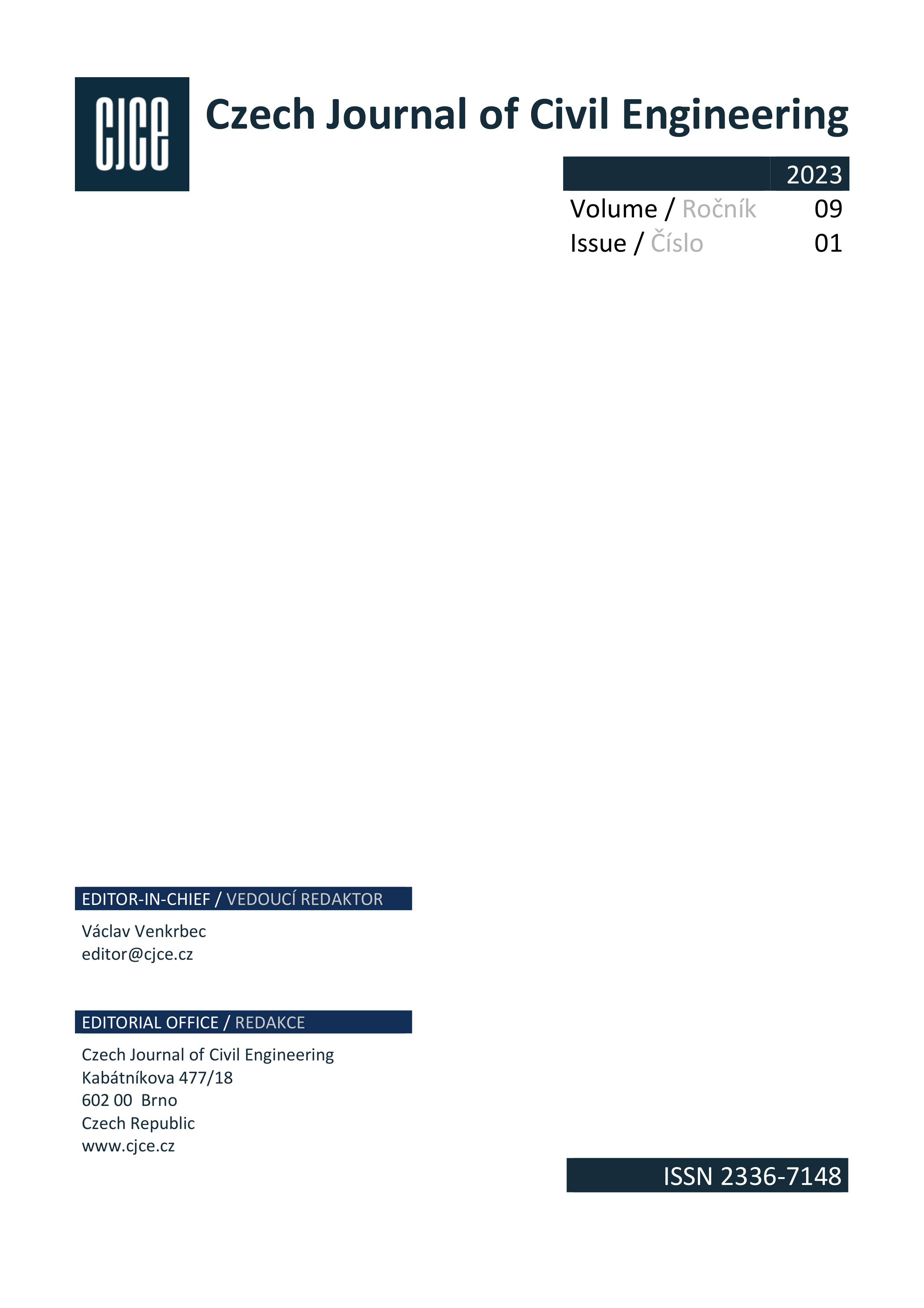Dátovo-orientovaný prístup na zníženie vlhkosti v pamiatkových budovách
DOI:
https://doi.org/10.51704/cjce.2023.vol9.iss1.pp23-34Klíčová slova:
Metodika zberu dát, vzlínajúca vlhkosť, BIM, sanačné opatrenia, TLSAbstrakt
Dnes sa v praxi používa viacero metód merania zameraných na identifikáciu úrovne vlhkosti stavebných konštrukcií. Namerané dáta je možné prepojiť s informačným modelom stavby, výsledkom čoho bude usporiadaná databáza, čo umožní nielen lepšie a komplexnejšie vyhodnocovanie, ale umožní automatizáciu vyhodnocovania s využitím umelej inteligencie. Problémom je najmä absencia informačných modelov stavby, ktoré obzvlášť pri historických objektoch nie sú k dispozícii. V tomto článku sa zameriavame na vytvorenie metodiky pre systematický zber údajov o vlhkostných pomeroch v konštrukciách pamiatkových objektov, ktorá bude podkladom pre návrh vhodných opatrení na úpravu. Prvým krokom je digitalizácia stavby prostredníctvom fotogrametrie, prípadne terestrického laserového skenovania. Druhým krokom je vytvorenie informačného modelu stavby. Posledným krokom je prepojenie informácií z merania s informačným modelom stavby. Obohatenie BIM o dátový súbor vlhkostných záznamov z rôznych budov môže výrazne prispieť lepšiemu pochopeniu miery zavlhnutia, identifikácii príčin a tiež napomôcť k výberu vhodných opatrení na základe navrhnutých opatrení v minulosti.
##plugins.generic.paperbuzz.metrics##
Reference
MAKÝŠ, O. 2018, Technológia Obnovy Budov, Ochrana a Oprava Spodných a Obalových Konštrukcií; Spektrum STU: Bratislava, Slovakia, s. 27–80.
CHAREF, Rabia, EMMITT, Stephen, ALAKA, Hafiz, FOUCHAL, Farid, 2019, Building Information Modelling adoption in the European Union: An overview, Journal of Building Engineering, Volume 25, 100777, ISSN 2352-7102, https://doi.org/10.1016/j.jobe.2019.100777
DORE, D., BILLARD, C. and NICOLLE, J., 2018, Combining 3D Modeling, Thermography and Dendrochronology for Assessing Moisture Damage in Historic Buildings, International Journal of Architectural Heritage, vol. 12, no. 4, pp. 602-615.
KRIJNEN, S., BOMMEL, E. van, 2020, A 3D BIM-based tool for assessing moisture risk in historic buildings, Automation in Construction, vol. 111, pp. 103-117.
GIANNAKIS, G. G., VENERI, A. F., KARYPIDIS, E. Z., 2019, Assessing moisture risk in historic masonry structures using thermal and visual imaging techniques, Journal of Cultural Heritage, vol. 39, pp. 117-125.
FABIANI, C., GAROZZO, M., PESCARIN, M., 2017, BIM and IR thermography for energy efficiency and conservation of historic buildings, Energy Procedia, vol. 140, pp. 301-310.
KOPÁČIK, A., ERDÉLIY, J., KYRINOVIČ, P., 2020, Engineering surveys for industry, pp. 1-213, ISBN 978-3-030-48308-1, https://doi.org/10.1007/978-3-030-48309-8
SUCHOCKI, C. 2020, Comparison of Time-of-Flight and Phase-Shift TLS Intensity Data for the Diagnostics Measurements of Buildings. Materials, 13, 353. https://doi.org/10.3390/ma13020353
SUCHOCKI, C., DAMIĘCKA-SUCHOCKA, M., KATZER, J., JANICKA, J., RAPIŃSKI, J., STAŁOWSKA, P., 2020, Remote Detection of Moisture and Bio-Deterioration of Building Walls by Time-Of-Flight and Phase-Shift Terrestrial Laser Scanners. Remote Sensors, 12, 1708. https://doi.org/10.3390/rs12111708
AIRA-ZUNZUNEGUI J. R., SÁNCHEZ-APARICIO M., SÁNCHEZ-APARICIO J. L., PINILLA-MELO J., GARCÍA-MORALES S., 2022, Determination of wood moisture content with terrestrial laser scanner, Construction and Building Materials, Volume 350, 128834, ISSN 0950-0618, https://doi.org/10.1016/j.conbuildmat.2022.128834
DAMIĘCKA-SUCHOCKA, M., KATZER, J., SUCHOCKI, C., 1963, Application of TLS Technology for Documentation of Brickwork Heritage Buildings and Structures. Coatings 2022, 12. https://doi.org/10.3390/coatings12121963
STN EN ISO 19650-1, 2018, Organizácia informácií o stavbách. Manažment informácií s využitím informačného modelovania stavieb (BIM). Časť 1: Pojmy a princípy (ISO 19650-1: 2018)
FUNTÍK, T. a kol., 2018, Building Information Modeling, Vydavateľstvo Eurostav, Bratislava, ISBN 978-80-89228-56-0.
STN EN ISO 19650-2, 2018, Organizácia informácií o stavbách. Manažment informácií s využitím informačného modelovania stavieb (BIM). Časť 2: Fáza dodania aktív (ISO 19650-2: 2018)
FRANZONI, E., 2014, Rising damp removal from historical masonries: A still open challenge, Construction and Building Materials vol. 54, pp. 123-136. https://doi.org/10.1016/j.conbuildmat.2013.12.054
GUOLO E., ROMAGNONI P., PERON F., 2021, Capillary rising damp in Venetian context: state of the art and numerical simulation, Journal of Physics: Conference Series, Volume 2069, 8th International Building Physics Conference (IBPC 2021) 25-27 August 2021, Copenhagen, Denmark, 2069, 012046
MAKÝŠ, O., 2014, Affects of Ventilation Technologies for Fighting Moisture in Baroque Masonry. CTM 2014 – Construction Technology and management 2014, pp. 315-320.
POCHMANOVÁ P., MISAR, I., 2011, Kontrolní metody pro stanovení vlhkosti podkladních vrstev podlah. Dostupé na: https://stavba.tzb-info.cz/podlahy/8050-kontrolni-metody-pro-stanoveni-vlhkosti-podkladnich-vrstev-podlah
FASSINA V., FAVARO M., NACCARI A., PIGO M., 2002, Evaluation of compatibility and durability of a hydraulic lime-based plaster applied on brick wall masonry of historical buildings affected by rising damp phenomena, Journal of Cultural Heritage,Volume 3, Issue 1, pp. 45-51. https://doi.org/10.1016/S1296-2074(02)01158-5
LUBELLI B., HEES, R.P.J.v., R., GROOT, C. W.P., 2006, Investigation on the behaviour of a restoration plaster applied on heavy salt loaded masonry, Construction and Building Materials, Volume 20, Issue 9, pp. 691-699, https://doi.org/10.1016/j.conbuildmat.2005.02.010.
SARDELLA, A:, DE NUNTIIS, P., BONAZZA, A., 2018, Efficiency evaluation of treatments against rising damp by scale models and test in situ, Journal of Cultural Heritage, Volume 31, Supplement, pp. 30-S37. https://doi.org/10.1016/j.culher.2018.03.020
EUSEBI V, MONTAGNA R, PAURI M, STAZI A., 1994, Recovery of rising-damp damaged masonry: experimental comparison between ‘slow diffusion’ and ‘under pressure’ procedures for waterproofing agents. In: Shrive NG, Huize A, editors. Proc 10th IB2MAC, Calgary, Canada, July 5–7, pp. 819–28.
PRÍDALOVÁ, Z., 2013, Prieskumy na návrh sanácie vlhkého muriva, Availibe on: https://www.asb.sk/stavebnictvo/zaklady-a-hruba-stavba/obvodove-konstrukcie/prieskumy-na-navrh-sanacie-vlhkeho-muriva
SASS, O., VILES, H.A., 2006, How wet are these walls? Testing a novel technique for measuring moisture in ruined walls, Journal of Cultural Heritage, Volume 7, Issue 4, pp.257-263. https://doi.org/10.1016/j.culher.2006.08.001
HEALY, W. M., 2003, Moisture sensor technology-a summary of techniques for measuring moisture levels in buildling envelopes. ASHRAE Trans. 109:232. https://www.proquest.com/scholarly-journals/moisture-sensor-technology-summary-techniques/docview/192512842/se-2
ČSN P 73 0610. 2000, Hydroizolace Staveb, Sanace Vlhkého Zdiva, Základní Ustanovení.
WITZANY, J., 1999, Poruchy a Rekonstrukce Zděných Budov; ČKAIT: Prague, Czech Republic.
Stahování
Publikováno
Jak citovat
Číslo
Sekce
Licence
Copyright (c) 2023 Tomáš Funtík, Patrik Šťastný, Ján Erdélyi, Richard Honti

Tato práce je licencována pod Mezinárodní licencí Creative Commons Attribution-NonCommercial-NoDerivatives 4.0.
Creative Commons Attribution-NonCommercial-NoDerivatives 4.0 International Public License
Články publikované v časopise Czech Journal of Civil Engineering podléhají licenci Creative Commons License. Není-li uvedeno jinak, jednotlivé články v časopise Czech Journal of Civil Engineering podléhají licenci typu Creative Commons Uveďte původ-Neužívejte komerčně-Nezpracovávejte 4.0 Mezinárodní Veřejná licence.









